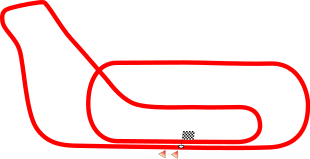Piero Puricelli
Piero Puricelli (born April 4, 1883 in Milan - died May 8, 1951 in Milan), Count of Lomnago, was an Italian engineer and politician in the first half of the 20th century who was responsible for the construction in Italy, of the first motorways in the world. He became a senator of Italy in 1929.
Family life
Piero Puricelli, Count of Lomnago,[1] was born the son of Angelo and Carlotta Combi. He attended the Federal Polytechnic Institute in Zurich, from which he graduated in Engineering in 1905. Puricelli married Antonietta Tosi; they had one son, Franco.[2]
The first Italian motorway

In the period following the First World War, after economic development recommenced in Italy, a project to build a motorway was conceived - that is "... a new road reserved exclusively for motor traffic ... ". In 1922 Puricelli designed the project, connecting Milan to Lake Como and Lake Maggiore[3]. On September 20, 1923, King Vittorio Emanuele III inaugurated the first section of the motorway, to Gallarate. For its time, this was a futuristic work: the cart and the bicycle were still the dominant means of personal transport in Italy at the time, and there were no more than 85,000 motor vehicles in Italy in 1924, half in Lombardy. On September 21, 1924, the extension to Varese was inaugurated. The Autostrada dei Laghi was the first exclusive-use motorway built in the world[3] because the high-speed AVUS road in Berlin was also used as a test track for motor vehicles. it:Autostrada dei Laghi
The Monza Racetrack

The Autodromo Nazionale di Monza (Monza National Racetrack) project was assigned to Arturo Mercanti, then director of the Automobile Club of Milan, and the engineers Alfredo Rosselli and Piero Puricelli.[1] The overall length was 10 kilometres (6.2 mi), comprising a 4.5 kilometres (2.80 mi) loop track, and a 5.5 kilometres (3.42 mi) road track.[4][5] The Automobile Club commissioned the construction of the racetrack in January 1922 to commemorate its twenty-fifth anniversary.[5] Work began on May 15 and was completed in just 110 days. Pietro Bordino and Felice Nazzaro completed the first lap of the track on July 28 in a Fiat 570. The national racetrack was the third permanent circuit in the world, preceded only by the Indianapolis Motor Speedway in the United States and by the English one at Brooklands, no longer in existence today. The choice of Monza was the result of studies seeking a location near Milan, to limit the "travel" costs for the maintenance of the racetrack. Setting aside alternative sites near Gallarate and Gagnola (a peripheral location in Milan), the directors of the ACI chose the park at the Villa Reale in Monza.The circuit was then known as "the fastest in the world".
Political career
Puricelli was appointed Senator on February 26th, 1929, proposed by the Italian National Fascist Party[1] and remained in office until his removal by the Alta Corte di Giustizia per le Sanzioni contro il Fascismo (High Court of Justice for Sanctions against Fascism) in 1945, for having been one of the "senators held responsible for maintaining fascism and making war possible, both by their votes and by their individual actions, including the propaganda exercised outside and inside the Senate."[2] In July 1946 he was acquitted of the charge of collaboration.[1]
Appointments
Among the appointments Piero Puricelli held are:
- Vice-president of the Bureau International des Expositions[2]
- Member of the Italian National Research Council
- 1923 Member of the Superior Council of Public Works
- 1927 President of the Milan Fair (until 1943)
- 1929 President of the public companies La strada and Autostrade[6]
- 1931 President of the International Union of Trade Shows[7]
- 1940 General Commissioner for Italy at the International Communications Exhibition in Cologne
Italian honors
- Cavaliere di Gran Croce decorato di Gran Cordone dell'Ordine della Corona d'Italia - nastrino per uniforme ordinaria (Knight of the Grand Cross decorated with the Great Cord of the Order of the Crown of Italy) - June 8, 1933
- Grand'Ufficiale dell'Ordine della Corona d'Italia - nastrino per uniforme ordinaria (Grand Officer of the Order of the Crown of Italy) - 3 June 1923
- Commendatore dell'Ordine della Corona d'Italia - nastrino per uniforme ordinaria (Commander of the Order of the Crown of Italy) - 14 January 1917
- Laurea honoris causa in ingegneria dal Politecnico di Milano - nastrino per uniforme ordinaria (Honorary degree in engineering from the Politecnico di Milano) - 1927 [2]
References
- "PURICELLI, Piero in "Dizionario Biografico"" [Piero Puricelli in the Biographical Dictionary of Italians]. www.treccani.it. Istituto dell'Enciclopedia Italiana.
- "Indice dell'Attività Parlamentare - Fascicolo personale" [Index of Parliamentary Activity - Personal file]. www.senato.it. Retrieved 15 January 2014.
- Lenarduzzi, Thea (January 30, 2016). "The motorway that built Italy: Piero Puricelli's masterpiece". The Independent.
- "1922–1928: Construction and first races on the original tracks". Autodromo Nazionale Monza. MonzaNet.it. 2007. Archived from the original on 11 June 2008. Retrieved 17 September 2009.
- "Autodromo Nazionale di Monza – History". The Formula One DataBase. F1db.com. 6 April 2005. Archived from the original on 2 October 2009. Retrieved 17 September 2009.
- Bortolotti, Lando (1978). Editori Riuniti (ed.). Storia della politica edilizia in Italia: proprietà, imprese edili e lavori pubblici dal primo dopoguerra ad oggi (1919-1970) [History of Building Policy in Italy: Property, Construction Companies and Public Works from the First World War to Today (1919-1970)]. Rome. p. 119.
- "Il sen. Puricelli nuovo Presidente dell'Unione delle Fiere" [Sen. Puricelli new President of the Union of Exhibitions]. L'industria: rivista tecnica ed economica illustrata: 429. 1931.